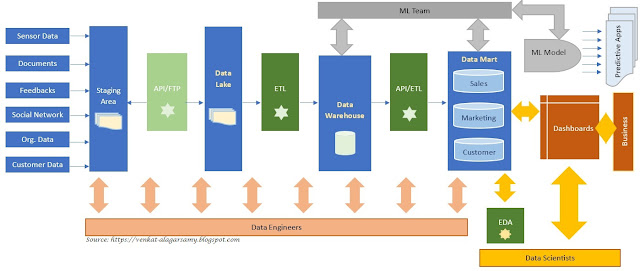Decoding Data Warehouse, Data Lake, and Data Mart: An In-Depth Comparative Analysis
In today's data-driven world, organizations face the challenge of effectively managing and utilizing vast amounts of data. Data Warehouse, Data Lake, and Data Mart are three commonly used architectures that play a crucial role in data management and analytics. In this comprehensive blog post, we will delve deep into these architectures, comparing their similarities, exploring their key differences, discussing design approaches from a data science and analytics perspective, and examining the benefits, challenges, and popular tools associated with each. By gaining a deeper understanding of these concepts, the stakeholders can make informed decisions for their organizations' data strategies.
Data Lake: Flexible and Scalable Storage for Diverse Data
Data Lake is a vast storage repository that stores raw, unstructured, and semi-structured data. Data Lake does not enforce a predefined schema, allowing for schema-on-read flexibility. Data Lakes can handle structured, semi-structured, and unstructured data, including text, images, videos, and IoT-generated data. This architecture supports data ingestion from diverse sources without the need for extensive transformation upfront. Data Lakes provide scalability, cost-effective storage, and agility in data exploration, enabling data scientists and analysts to perform advanced analytics and derive valuable insights.
A Data Warehouse is a centralized repository that stores structured and processed data. It serves as the foundation for business intelligence, reporting, and historical analysis. The data within a Data Warehouse is typically pre-aggregated, optimized for query performance, and aligned with the organization's predefined schema. Data Warehouses employ Extract, Transform, Load (ETL) processes to integrate and consolidate data from various sources. This architecture ensures data consistency, quality, and reliable insights for decision-making.
Data Mart: Focused Subset for Specific Business Needs
A Data Mart is a subset of a Data Warehouse or Data Lake, focusing on specific business functions, user groups, or departments. Data Marts are optimized for specific analytical queries, making data access more efficient and improving query performance. They provide targeted, simplified access to data, enhancing the user experience for business analysts and decision-makers. Data Marts can be derived from the main repository, ensuring alignment with the central data store while catering to the unique requirements of specific business units or use cases.
Design Approaches: Data Science and Analytics Perspective
Data Lake: Data Lakes accommodate raw, unstructured, and semi-structured data. They embrace a late-schema-on-read approach, enabling data ingestion without extensive upfront transformations. Data Lakes support both batch and real-time processing, fostering exploratory analysis and facilitating data exploration for data scientists and analysts.
Data Warehouse: Data Warehouses are designed to support structured and processed data. They facilitate batch processing and aggregated reporting, making them ideal for historical analysis and business intelligence. Data Warehouses provide a structured framework that ensures data quality, governance, and standardized reporting.
Data Mart: Data Marts are specialized subsets of Data Warehouses or Data Lakes, tailored to specific business functions or user groups. They provide focused and optimized data access, enhancing query performance and simplifying data availability for end-users. Data Mart offers a balance between centralized data governance and targeted analytics requirements.
Data Lake, Data Warehouse, and Data Mart are foundational elements in modern data management and analytics strategies. By understanding their similarities, key differences, design approaches, benefits, challenges, and the tools associated with each, CEOs, CTOs, CIOs, data architects, data scientists, data engineers, and application developers can make informed decisions regarding data storage, processing, and analysis. Aligning the chosen architecture with specific business requirements empowers organizations to unlock the full potential of their data assets, derive valuable insights, and drive growth and innovation.
Cheers,
Venkat Alagarsamy





Data warehouse and data lake are being aggregated under data fabric - which provides much more semnatically rich environment for Dataops and MLaaS.
ReplyDeleteThank you for your insightful comment. It's true that data warehouse and data lake concepts are frequently combined within a data fabric to establish a more semantically rich environment for DataOps and MLaaS. This integrated approach offers several advantages, including improved data integration, enhanced governance, and increased accessibility. By bringing data warehouses and data lakes together under a data fabric, organizations can foster a unified ecosystem that empowers data-driven decision-making and facilitates the effective implementation of machine learning initiatives.
DeleteKudos Author! It's a great article. Thanks for sharing this useful information. If you are looking for any data-related services/solutions listed below, Kindly reach us.
ReplyDeleteData Engineering Services
Data Analytics Services
Data Warehouse Services
Data Modernization Services
Data Migration Services
Cloud Data Management Services
Data Visualization Services
Predictive Analytics Services
Text Analytics Services